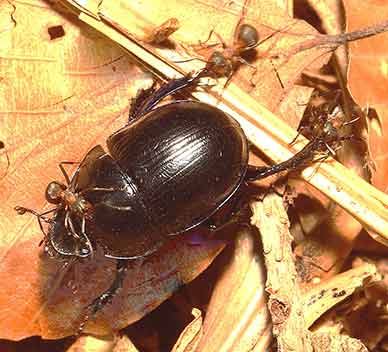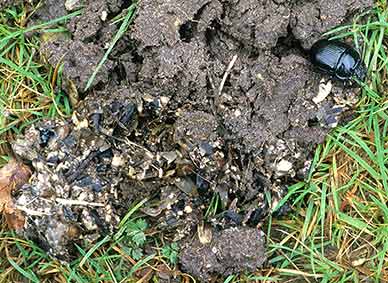Dung beetles
Dor beetle (Geotrupes stercorarius)
Wood dor beetle (Geotrupes stercorosus)
Minotaur beetle (Typhaeus typhoeus)
When: Mainly seen from March - November
How many: Fairly numerous and quite widespread

the attention of southern wood ants
When walking along grassy woodland rides, look out in spring and summer for quite large, dark coloured beetles. If they are beside animal dung or close to a small, circular hole in the ground, they’re probably dung beetles.
By human standards, dung beetle habits are none too savoury, but many people with an interest in the natural world are likely to be fascinated by these strange creatures and their somewhat bizarre ways.
In the New Forest, three dung beetle species are present – the dor beetle, wood dor beetle and minotaur beetle. And of course, there’s plenty of dung for all – commoners’ stock, deer and other animals see to that.
Dung beetle males are larger than females, but both sexes are quite stocky insects that, in the dor beetle, the largest of the three, can grow to a length of almost 2 centimetres (almost 1 inch).
All these dung beetles have shiny, dark-coloured, strongly ridged wing cases, and an equally dark head and thorax – the middle bit, behind the head. Dor and wood dor beetles have a quite striking green, blue or purple iridescent sheen, whilst minotaurs are normally just glossy black.
All also have large, spiky front legs, specially adapted for digging.
Minotaur males are the most distinctive, though. They’re equipped with two quite prominent, forward pointing horns protruding from the thorax, and another smaller, centrally placed horn, all for use in battle with other, competing males. minotaur females, though, have virtually no horns.
There is no getting away from it, though - dung beetles are closely associated with dung. In fact, they’re more than closely associated with it – they eat it to the exclusion of almost all else.
Cow pats, horse droppings, fox scats: nothing goes to waste, although some have a strong preference for the dung of particular animals – minotaurs, for example, favour rabbit droppings, whilst dor beetles are very partial to cow pats.
Then if eating dung is not enough, supplies are stored for future use in shallow tunnels, and provisions set aside for newly hatched dung beetle youngsters in specially constructed, underground nest chambers running off a vertical tunnel that in some cases is 50 centimetres (24 inches) deep.
Dung is taken down into the nest, mixed with fragments of wood and placed in each of the chambers. Eggs are laid, one in each chamber, beside or within the ready-made food supply, just waiting for the dung beetle larvae to hatch out and tuck in.

dung beetle taking away a fox dropping
that contains the remains of other dung beetles
The fleshy, white, C-shaped dung beetle larvae feed until autumn, often hibernate over winter, resume feeding and in spring pupate in the surrounding soil. The next dung beetle generation appears during the summer, hibernates over winter and re-appears in the following spring ready itself to breed. It’s a simple, but highly effective strategy.
Dung beetles are common in many New Forest woodland inclosures, and form an important part of the diet of foxes, tawny owls and other predators that, in the relative absence of small mammals, are no doubt pleased to supplement their diet with generous helpings of portly, well-fed beetles.
In fact, on many New Forest woodland rides, fox scats packed with dung beetle wing cases provide much-favoured food for these burrowing beetles in what is a strange, coincidental, mutually beneficial relationship.
References:
Collins Guide to the Insects of Britain and Western Europe: Michael Chinery
Insects of Britain and Europe: J. Zahradnik and M. Chvala
The Living Countryside – Scavenging Dung Beetles
More links
Other related links
Search this site

Sadly, 58 animals were killed - 35 ponies, 13 cows, 8 donkeys and 2 sheep, whilst a further 32 were injured - 3 pigs, 9 donkeys, 11 cows and 9 ponies.
(Forty-three accidents occurred in daylight, 15 at twilight and 101 in the dark. Twenty-seven accidents were not reported by the driver involved).
Here's just one horrific example - Three donkeys killed in collision with van at notorious New Forest blackspot (Advertiser and Times)

